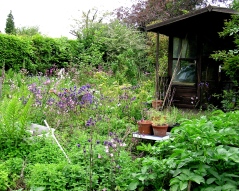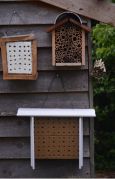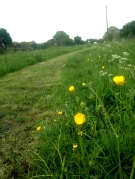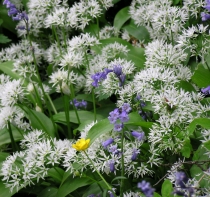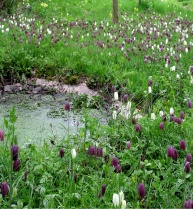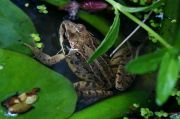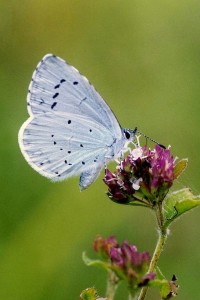At a time when the latest UK research indicates a 60% decline in studied wildlife species there is an urgent need for us all to get involved and help in some way. Many garden favourites are among the creatures shown to be in serious trouble such as starlings, toads, hedgehogs, some butterflies and ladybirds. There are a number of ways that we as individuals can help restore, improve or increase suitable habitat for our native wildlife. One of the easiest and most direct ways is via our gardens of which there are 15 million equating to 500,000 hectares across the UK. (Source: http://www.plantlife.org.uk 2006).
According to the RSPB ‘Gardens may provide a breeding habitat for at least 20% of the UK populations of house sparrows, starlings, greenfinches, blackbirds and song thrushes four of which are declining across the UK’.
With a few minor changes gardeners can have a significant and almost immediate positive effect on habitat restoration and improvement for native wildlife. Growing a variety of nectar rich flowering plants, shrubs, hedgerow and trees – especially native wild flowering plants – and avoiding ‘double’ flower varieties and bedding plants is key to creating an instant bee & butterfly cafe in your garden. Double flower varieties are impossible for pollinators to access for nectar and bedding plants are often sterile offering little or no nectar.
Bee and bug hotels are easy to make and can provide a much needed instant habitat on a warm wall or garden shed. Installing nest boxes for different bird species away from feeding stations and direct sunlight will also help your garden birds immensely. You may even find that once the birds have left the nest box it may become a preferred temporary home for bees as my neighbour, Erin, recently found in her garden.
It’s been great to see that some locals are now mowing pathways through long grass allowing a range of native wild flowers to flourish and provide nectar for pollinators rather than completely mowing the areas in front of their homes. Even the government has taken steps to enforce a more sympathetic mowing regime by our councils and their contractors of roadside verges to allow wild flowers to flourish as a response to the crisis of the declining bee population.
Lord De Mauley said a new National Pollinator Strategy will be published by November and the actions will start “immediately” so that bees are protected when they come out in spring.
“We must develop a better understanding of the factors that can harm these insects and the changes that government, other organisations and individuals can make to help.” (Source: Louise Gray Environment Correspondent, The Telegraph 28/06/2013).
A change in our mowing regime is also important as certain butterflies such as small and large skippers need tall grasses on which to lay their eggs, the larvae overwinter and in turn their caterpillars provide additional protein rich food in spring for birds. And nettles support an astonishing 30 different species during a full life cycle and provide nectar if allowed to flower.
I recently visited local gardener Paul Mathews who has spent the last 20 years creating a gorgeous wild flower garden sometimes from seeds and plants he’s rescued prior to various land developments. I was particularly impressed with a large area of fragrant Wild Garlic and another area of over a 1000 Cowslips and Snakeshead Fritilliaries propagated by Paul from just a few original rescued wild seeds.
Paul’s garden contains a diverse range of habitats and plants with a variety of areas left undisturbed, which is perfect for attracting native wildlife. Paul realises that a tidy garden is a sterile garden and his garden is healthier because some areas are left untouched and overgrown. He practices a mowing regime that allows longer grass to grow around edges and strips and also allows Knapweed, Meadow Sweet, Meadow Cranesbill and Bird’s Foot Trefoil to flourish. Paul does not treat his grass with a ‘feed and weed’ formula as this would stop the emergence of wild flowers and also inhibit Chafer larvae, a soil dwelling grub produced from Chafer beetles which provide a protein rich food for Green Woodpeckers and small mammals.
Paul practices companion planting on his vegetable patch so there is little need for garden chemicals and the pond is home to frogs which help keep slugs at bay. Paul has also created a woodland pond which is fed via a pipe re routing the rain water run off from his house and the pond boasts a truly stunning display of Snakeshead Fritilliaries, Wood Anenomes, Violets, Primroses and Cowslips in Spring. It’s worth noting that a pond can be really small and still benefit wildlife but one thing to remember if you have a pond or are thinking of installing one make sure it has shallow edges, and includes aquatic planting to allow escape routes for creatures that might end up there unintentionally. I’ve added logs and gravel edges to my mini pond and it’s now home to frogs, toads, damsel flies and a whole host of insects and amphibians. It provides drinking water for the garden birds and is the best place to watch if I want to see who’s visiting my garden.
By considering the native wildlife and creating suitable habitats Paul has been rewarded with a beautiful garden with an abundance of wildlife including, field vole, wood mice and grass snakes. Grass snakes are one of only three snake species found in England and Wales and are also the largest reptile and only egg laying snake. They are completely harmless and are very timid often feigning death if disturbed. They love rotting vegetation and garden compost heaps as the warmth generated by decomposition helps to incubate their eggs. Sadly they are also now thought to be in decline. Paul’s garden is also home to a variety of bees and numerous butterflies, hoverflies, damselflies and lots of birds. On the day that I visited the bees were in good numbers busily collecting nectar even though it was cold.
If you want to attract more wildlife to your garden you can start by adding a log pile and creating a leaf litter corner which will attract a whole ecosystem of invertebrates, frogs and reptiles to predate on unwanted pests such as slugs. Also avoid solid barriers as wildlife need to enter and exit your garden, leaving a 4″ gap will allow hedgehogs to come and go as they require and whilst they are around they will eat a lot of slugs and snails for you. If you don’t have a pond put out fresh water at ground level and also higher up for birds but don’t forget to keep it clean and refresh it regularly.
In addition wait until Spring to cut back summer perennial stalks and dead growth. They provide an essential habitat for overwintering invertebrates, which in turn provide much needed protein for garden birds in Spring. And limit your hedgerow cutting to Spring and Autumn so that nesting birds and their fledglings are left undisturbed.
Once you’ve created your garden wildlife habitat it’s important to consider the damage that garden chemicals and bug killers will do to your visiting pollinators as they usually contain neonicotinoids which have been developed to attack the nervous system. Neonicotinoids work in a systemic way which means they are within every part of a treated plant or seed, their effects are now linked to the global collapse of the honey bee population. Unfortunately garden centres are also pre treating plants and the compost they sit in with neonicotinoids and so we could be filling our gardens with killer plants. So when you buy a plant it’s not only important to consider it’s value as a nectar source but to ask the retailer whether they treat their plants and seeds with neonicotinoids.
For butterfly friendly gardens try planting: cowslip, field pansy, foxglove, wild geranium, heather, honeysuckle, nasturtium, pelargoniums, vipers bugloss, wild marjoram, wild thyme, wild pansy, wood avens, wild strawberry,wild plum, ivy holly, hawthorne and dog rose.
For bee and hoverfly, friendly gardens you’ll get great results if you plant the following and allow them to flower; marjoram, oregano, lavender, thyme, hollyhock, lupins, delphinium, buddlija, honeysuckle, jasmine, sweet peas, chives, fennel, rocket, leek, alliums, oxeye daisy and red campion.
Then sit back and enjoy the buzz.
For a more comprehensive plant list go to:
http://www.ukbutterflies.co.uk/foodplants.php
http://www.buzzaboutbees.net/wildflowers-for-bees.html
For more detailed information on how to create great wildlife habitat for amphibians visit: http://www.arc-trust.org/dragons/enhancing.php
For full instructions on how to make a bee hotel visit: http://www.foe.co.uk/resource/briefing_notes/bee_hotel.pdf
For further information on how to make your garden hedgehog friendly visit: http://www.hedgehogstreet.org/

